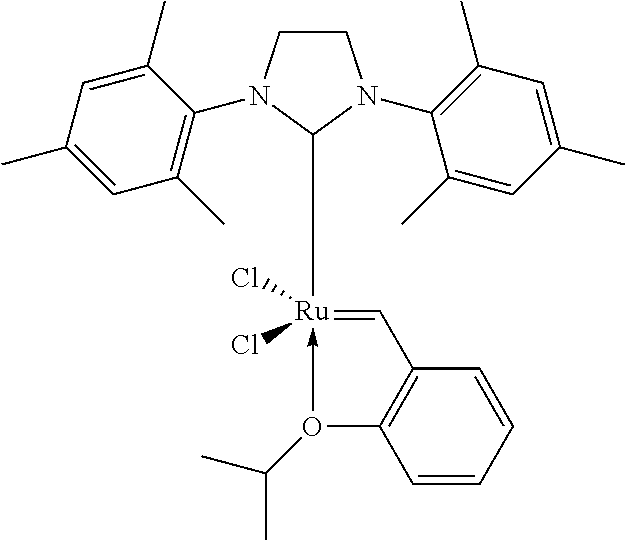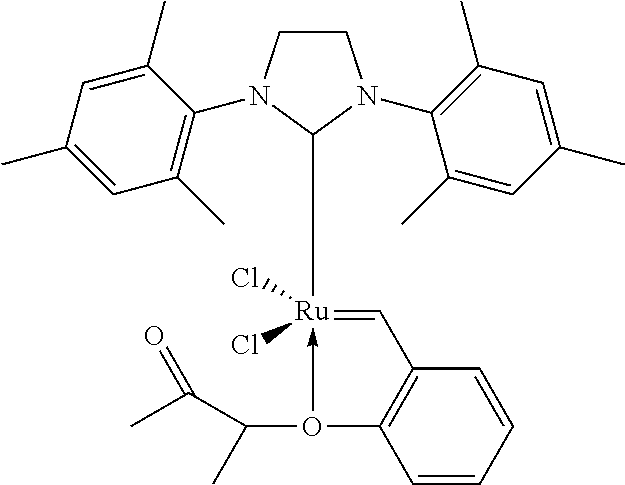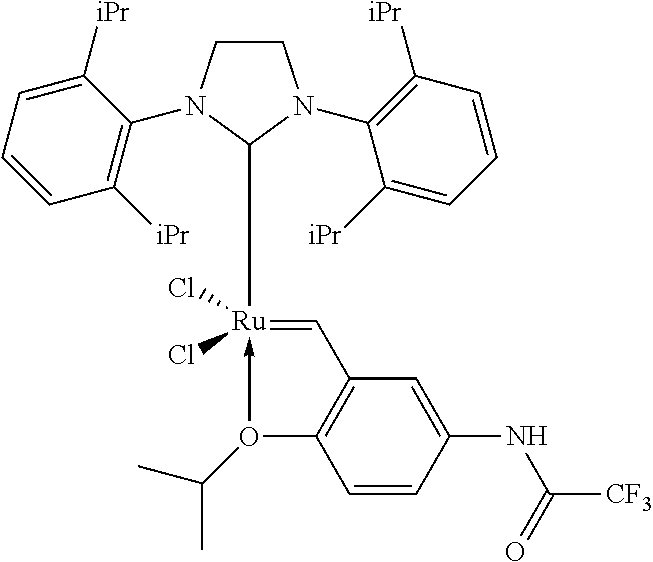Synthesis of a branched unsaturated compound by means of cross metathesis
a technology of unsaturated and unsaturated compounds, which is applied in the preparation of carboxylic compounds, fatty acid chemical modifications, organic chemistry, etc., can solve the problems of rareness, sparing commercial availability, and particularly expensive, and none of these methods is entirely satisfactory
- Summary
- Abstract
- Description
- Claims
- Application Information
AI Technical Summary
Benefits of technology
Problems solved by technology
Method used
Image
Examples
example 1
[0128]The test is performed in the following experimental device.
[0129]The device is composed of a 600 ml round-bottomed flask equipped with a nitrogen inlet, a temperature probe, a cooler (on which is mounted a tap and which exits to a bubbler), an oil bath and an inlet for the reagents, and a syringe pump bearing syringes for injecting the olefin and the catalyst, which are added continuously.
[0130]The assembly is first purged with nitrogen, the supply of which will be stopped at the time of loading of the olefin and the catalyst.
[0131]The catalyst M71SiPr from Umicore is prepared as follows: 10.2 mg, weighed out in a glass crucible, are dissolved in 21.6 g of toluene in a Schlenk tube under nitrogen. 5 ml of this solution, i.e. 2.02 mg of catalyst, are introduced into a first syringe.
[0132]A second syringe is prepared, into which are placed 4.4 g of 5-methyl-1-hexene (molar mass: 98 g / mol), i.e. 44 mmol.
[0133]The reactor is loaded with 150 g of toluene and then with 15 g of methy...
example 2
Cross Metathesis of Methyl Decenoate+Neohexene
[0138]
[0139]10 g of methyl 9-decenoate (54 mmol) purified on alumina, 18.1 g of 3,3-dimethyl-1-butene (neohexene, 215 mmol, 4 equivalents) and 100 g of toluene are placed in a 250 ml 10 glass reactor purged with nitrogen. The mixture is heated at 40° C., followed by addition, over a period of 2 hours, of 3.4 mg of catalyst M73-SiPr supplied by the company Umicore (75 ppm mol) dissolved in 5 ml of toluene. At the end of the addition, the degree of conversion of the methyl decenoate, measured by CPG, is 86%. The selectivity toward cross metathesis product is 35%.
PUM
| Property | Measurement | Unit |
|---|---|---|
| Temperature | aaaaa | aaaaa |
| Temperature | aaaaa | aaaaa |
| Pressure | aaaaa | aaaaa |
Abstract
Description
Claims
Application Information
 Login to View More
Login to View More - R&D
- Intellectual Property
- Life Sciences
- Materials
- Tech Scout
- Unparalleled Data Quality
- Higher Quality Content
- 60% Fewer Hallucinations
Browse by: Latest US Patents, China's latest patents, Technical Efficacy Thesaurus, Application Domain, Technology Topic, Popular Technical Reports.
© 2025 PatSnap. All rights reserved.Legal|Privacy policy|Modern Slavery Act Transparency Statement|Sitemap|About US| Contact US: help@patsnap.com



